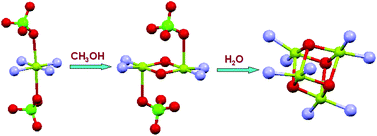A {Cu4(μ3-OH)4} compound, where four copper(II) and four μ3-bridging oxygen atoms occupy alternate corners of a slightly distorted cube, has been prepared and structurally characterized. This species, formulated as [Cu4(μ3-OH)4(Htmpz)8](ClO4)4·1.5Et2O (Htmpz = 3,4,5-1H-trimethyl pyrazole), can be classified as belonging to type I Cu4O4 cubane complexes, and is better described as two CuII–(μ-OH)2–CuII units held together by four long Cu–O bonds. The central distorted cubane core is stabilized by neutral monodentate ligands (Htmpz) and perchlorate anions, as demonstrated by single-crystal X-ray structure analysis. The title compound was obtained by hydrolysis of a dinuclear methoxo-bridged species, [Cu(μ-OCH3)(Htmpz)2]2(ClO4)2, which was prepared by reaction of [Cu(Htmpz)4(ClO4)2] with methanol. All these reactions represent a nice example of the Goldilocks principle in action in coordination chemistry, since each single actor (solvent, counteranion, and ligand) has the “just right” electronic, steric or coordinative properties which determine the fate of the final products.

You have access to this article
 Please wait while we load your content...
Something went wrong. Try again?
Please wait while we load your content...
Something went wrong. Try again?


 Please wait while we load your content...
Please wait while we load your content...